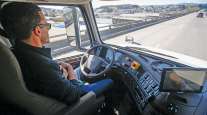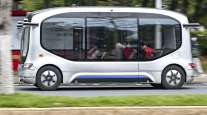Video From Self-Driving Uber Car Captures First Fatal Collision

Police in Tempe, Ariz., on March 21 released dashcam videos of the fatal accident March 18 in which an Uber car operating in autonomous mode struck and killed a pedestrian, showing the car did not slow down or alter its course to avoid her.
The first part of the 21-second clip show the car’s external view of the road ahead with an obstacle visible in the car’s lane that turns out to be a woman wearing blue jeans and a black top slowly walking a red bicycle. It ends just before the moment of impact. The woman, Elaine Herzberg, 49, of Mesa, Ariz., died of her injuries at a local hospital.
The rest of the clip was taken facing inside the car, showing the backup driver, who is looking down. It ends abruptly with the driver’s mouth falling open, presumably at the moment of impact.
TO WATCH VIDEO: Go to Tempe, Ariz., police department tweet
“The video clearly shows a complete failure of the system to recognize an obviously seen person who is visible for quite some distance in the frame,” said Michael Ramsey, research director with Gartner and an expert on self-driving cars. “Uber has some serious explaining to do about why this person wasn’t seen and why the system didn’t engage.”
“The video is disturbing and heartbreaking to watch, and our thoughts continue to be with Elaine’s loved ones,” Uber said in a statement. “Our cars remain grounded, and we’re assisting local, state and federal authorities in any way we can.”
Sylvia Moir, Tempe police chief, told The Chronicle on March 19 that from her viewing of the video, it appeared that neither the driver nor the self-driving car were at fault. She did not respond to an inquiry March 21 about whether she had reconsidered that statement.
The self-driving car was equipped with multiple sensors, including video cameras, radar and lidar, a laser form of radar. Although the technology is still under development, robot cars are intended to be superior to human drivers because they have a 360-degree view of their surroundings and don’t get distracted.
UBER SUSPENDS TESTING: Self-driving cars, trucks put on pause.
While video cameras capture better views with more light, the car’s other sensors should not have been affected by the nighttime hour.
“There is no question the laser should have seen her,” said Brad Templeton, a Silicon Valley entrepreneur who was an early consultant on Google’s self-driving project. “I know the technology is better than that, so I do feel that it must be Uber’s failure.”
Uber has suspended tests of autonomous vehicles, including trucks, in all four cities where it operates them (Tempe, San Francisco, Pittsburgh and Toronto). The accident, the first pedestrian fatality involving a robot car, has cast a shadow on the nascent industry.
Police have said there is no sign that the self-driving Volvo SUV, which was traveling at 38 miles per hour, slowed down before the impact. Although the video does not show it, the police department’s explanation of the woman’s route across the road means that she had already crossed two lanes before she was in front of the car.
Although the car was driving itself, it had a backup driver behind the wheel, whose role was to take control if necessary. The driver has been identified as Rafaela Vasquez, 44.

A still photo from internal dashcam video shows the Uber driver, identified as Rafaela Vasquez, looking up and reacting a split second before the collision with the pedestrian. (Tempe, Ariz., police department via AP)
“It’s clear the safety driver is distracted, looking down right up until the impact,” Ramsey said. “It brings up a whole slew of questions about Uber’s system and how it could possibly have not detected that.”
Templeton agreed. “The safety driver did not do her job properly,” he said. “The driver’s job is to remain vigilant on the road situation.”
Ramsey and Templeton both said that the automatic braking and forward-collision warning that are stock features on high-end cars such as the Volvo XC90 that Uber uses in its tests should have detected the pedestrian and at least slowed the car. “Probably, that Volvo had it, but it was turned off,” Templeton said.
Distributed by Tribune Content Agency, LLC




